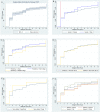Factors associated with delay in post-exposure prophylaxis in bitten people
- PMID: 25695016
- PMCID: PMC4322343
Factors associated with delay in post-exposure prophylaxis in bitten people
Abstract
Background: Although the incidence of animal bite is increasing in Iran, there is no sufficient knowledge about delayed Post-Exposure Prophylaxis (PEP). Hence, the aim of this study was to evaluate delayed PEP and its associated factors in bitten people.
Methods: This cross-sectional study was conducted in Tuyserkan district of Hamadan Province (West of Iran) from February 2011 to February 2012 and included 425 cases of animal bites recorded in the Rabies Treatment Center (RTC) using the census method. The associations between delayed PEP and each of the potential risk factors were investigated using Chi-square test.
Results: Of 425 registered cases, 71.8% were male and 81.2% were from rural areas. The mean age of the subjects was 32.4 years (±21.3). Dogs were the most frequent source of exposure (69.4%), and the most common bitten part of the body was legs (49.4%). With respect to the wounds, 16.2% of the cases had deep injuries. Overall, 37.2% of the cases received timely PEP (less than 6 hours). Delayed PEP was associated with sex (p= 0.001), type of animal (p= 0.020), injury status (p<0.001), place of residence (p= 0.006) and distance from RTC (p<0.001).
Conclusion: Although all victims of animal bite injuries suspected to be rabid, they received complete PEP. However, delayed time of PEP was still very high. The factors associated with delayed PEP may help health care workers to prevent adverse disease outcomes. Furthermore, considering the results of this study, it is highly recommended that proper attention and emphasis be given to public educational programs on dog behavior, dogchild interaction, the risk of dog bites and bite wound management for the general population, particularly children.
Keywords: Animal bites; Post-Exposure Prophylaxis; Rabies; Vaccination.
References
-
- World Health Organization. Rabies. Geneva: WHO; 2013; Available from: http://www.who.int/mediacentre/factsheets/fs099/en/.
-
- Sabouri Ghannad M, Roshanaei G, Rostampour F, Fallahi A. An epidemiologic study of animal bites in Ilam Province, Iran. Arch Iran Med. 2012;15(6):356–60. - PubMed
-
- Sheikholeslami NZ, Rezaeian M, Salem Z. Epidemiology of animal bites in Rafsanjan, southeast of Islamic Republic of Iran, 2003–05. East Mediterr Health J. 2009;15(2):455–7. - PubMed
-
- Bijari B, Sharifzade GR, Abbasi A, Salehi S. Epidemiological survey of animal bites in east of Iran. Iran J Clin Infect Dis. 2011;6(2):90–2.
LinkOut - more resources
Full Text Sources
Miscellaneous

